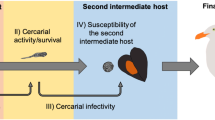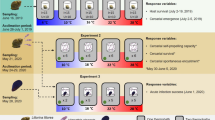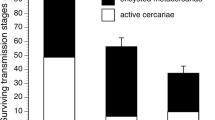Abstract
Salinity levels vary spatially in coastal areas, depending on proximity to freshwater sources, and may also be slowly decreasing as a result of anthropogenic climatic changes. The impact of salinity on host–parasite interactions is potentially a key regulator of transmission processes in intertidal areas, where trematodes are extremely common parasites of invertebrates and vertebrates. We investigated experimentally the effects of long-term exposure to decreased salinity levels on output of infective stages (cercariae) and their transmission success in the trematode Philophthalmus sp. This parasite uses the snail Zeacumantus subcarinatus as intermediate host, in which it asexually produces cercariae. After leaving the snail, cercariae encyst externally on hard substrates to await accidental ingestion by shorebirds, which serve as definitive hosts. We found that at reduced salinities (25 or 30 psu), the cercarial output of the parasite was lower, the time taken by cercariae to encyst was longer, fewer cercariae successfully encysted and encysted parasites had lower long-term survival than at normal seawater salinity (35 psu). The strong effect of salinity on the replication and transmission of this parasite suggests that there may be sources and sinks of transmission to birds along coastal areas, depending on local salinity conditions. Also, unless it evolves to adapt to changing conditions, the predicted reduction in salinity as a consequence of climate change may have negative impact on the parasite’s abundance.






Similar content being viewed by others
References
Adam P (1993) Saltmarsh ecology. Cambridge University Press, Cambridge
Anderson P, Nowosielski J, Croll N (1976) The emergence of cercariae of Trichobilharzia ocellata and its relationship to the activity of its snail host Lymnaea stagnalis. Can J Zool 54:1481–1487
Berger V, Kharazova A (1997) Mechanisms of salinity adaptations in marine molluscs. Hydrobiologia 355:115–126
Cheng R, Casulli V, Gartner J (1993) Tidal, residual, intertidal mudflat (TRIM) model and its applications to San Francisco Bay, California. Estuar Coast Shelf Sci 36:235–280
Cheung S, Lam S (1995) Effect of salinity, temperature and acclimation on oxygen consumption of Nassarius festivus (Powys, 1835)(Gastropoda: Nassariidae). Comp Biochem Physiol A 111:625–631
Crain C, Silliman B, Bertness S, Bertness M (2004) Physical and biotic drivers of plant distribution across estuarine salinity gradients. Ecology 85:2539–2549
Deschaseaux E, Taylor A, Maher W, Davis A (2010) Cellular responses of encapsulated gastropod embryos to multiple stressors associated with climate change. J Exp Mar Biol Ecol 383:130–136
Dixon K (1975) The structure and composition of the cyst wall of the metacercaria of Cloacitrema narrabeenensis (Howell & Bearup, 1967) (Digenea: Philophthalmidae). Int J Parasitol 5:113–118
Evans N (1982) Effects of copper and zinc on the life cycle of Notocotylus attenuatus (Digenea: Notocotylidae). Int J Parasitol 12:363–369
Fredensborg BL, Mouritsen KN, Poulin R (2005) Impact of trematodes on host survival and population density in the intertidal gastropod Zeacumantus subcarinatus. Mar Ecol Prog Ser 290:109–117
Graczyk T, Shiff C (1994) Viability of Notocotylus attenuatus (Trematoda: Notocotylidae) metacercariae under adverse conditions. J Wildl Dis 30:46–50
Harvell CD, Mitchell CE, Ward JR, Altizer S, Dobson AP, Ostfeld RS, Samuel MD (2002) Climate warming and disease risks for terrestrial and marine biota. Science 296:2158–2162
Hylleberg J (1975) The effect of salinity and temperature on egestion in mud snails (Gastropoda: Hydrobiidae). Oecologia 21:279–289
Ingole B, Parulekar A (1998) Role of salinity in structuring the intertidal meiofauna of a tropical estuarine beach: Field evidence. Indian J Mar Sci 27:356–361
Intergovernmental Panel on Climate Change (IPCC) (2007) Climate Change 2007: the physical science basis. Contribution of working group I to the fourth assessment report of the intergovernmental panel on climate change. Cambridge University Press, Cambridge
Kalantan A, Arfin M, Al-Arefi H, Bobshait H, Hamadah S, Al-Thawab F, Al-Shamrani A (1997) Occurrence of larval Philophthalmus gralli (Mathis and Leger, 1910) in freshwater snail Melanoides tuberculatus (Muller) from Al-Hafuf, Saudi Arabia and its development into adult in various experimental hosts. Parasitol Int 46:127–136
Kanev I, Radev V, Fried B (2005) Family Philophthalmidae Looss, 1899. In: Jones A, Bray RA, Gibson DI (eds) Keys to the Trematoda, vol 2. CABI Publishing, Wallingford, pp 87–97
Knauss J (1978) Introduction to physical oceanography. Prentice Hall, New Jersey
Koprivnikar J, Poulin R (2009) Effects of temperature, salinity, and water level on the emergence of marine cercariae. Parasitol Res 105:957–965
Koprivnikar J, Lim D, Fu C, Brack S (2010) Effects of temperature, salinity, and pH on the survival and activity of marine cercariae. Parasitol Res 106:1167–1177
Kuris A, Hechinger R, Shaw J et al (2008) Ecosystem energetic implications of parasite and free-living biomass in three estuaries. Nature 454:515–518
Lafferty K (1993) Effects of parasitic castration on growth, reproduction and population dynamics of the marine snail Cerithidea californica. Mar Ecol Prog Ser 96:229–237
Lafferty KD (2009) The ecology of climate change and infectious diseases. Ecology 90:888–900
Martorelli SR, Fredensborg BL, Leung TLF, Poulin R (2008) Four trematode cercariae from the New Zealand intertidal snail Zeacumantus subcarinatus (Batillariidae). N Z J Zool 35:73–84
Moore J (2002) Parasites and the behavior of animals. Oxford University Press, Oxford
Mouritsen KN (2002) The Hydrobia ulvae–Maritrema subdolum association: influence of temperature, salinity, light, water-pressure and secondary host exudates on cercarial emergence and longevity. J Helminthol 76:341–347
Mouritsen KN, Poulin R (2002) Parasitism, community structure and biodiversity in intertidal ecosystems. Parasitology 124:S101–S117
Mouritsen KN, Poulin R (2005) Parasites boost biodiversity and change animal community structure by trait-mediated indirect effects. Oikos 108:344–350
Mouritsen KN, Tompkins DM, Poulin R (2005) Climate warming may cause a parasite-induced collapse in coastal amphipod populations. Oecologia 146:476–483
Nollen P, Kanev I (1995) The taxonomy and biology of philophthalmid eyeflukes. Adv Parasitol 36:205–269
Pequeux A (1995) Osmotic regulation in crustaceans. J Crustacean Biol 15:1–60
Pietrock M, Marcogliese D (2003) Free-living endohelminth stages: at the mercy of environmental conditions. Trends Parasitol 19:293–299
Poulin R (2006) Global warming and temperature-mediated increases in cercarial emergence in trematode parasites. Parasitology 132:143–151
Poulin R (2010) Parasite manipulation of host behavior: an update and frequently asked questions. Adv Study Behav 41:151–186
Poulin R, Mouritsen KN (2006) Climate change, parasitism and the structure of intertidal ecosystems. J Helminthol 80:183–191
Shock B, Foran C, Stueckle T (2009) Effects of salinity stress on survival, metabolism, limb regeneration, and ecdysis in Uca pugnax. J Crustacean Biol 29:293–301
Shumway S (1979) The effects of fluctuating salinity on respiration in gastropod molluscs. Comp Biochem Physiol A 63:279–283
Sousa W (1991) Can models of soft-sediment community structure be complete without parasites? Am Zool 31:821–830
Southgate V (1971) Observations on the fine structure of the cercaria of Notocotylus attenuatus and formation of the cyst wall of the metacercaria. Cell Tissue Res 120:420–449
Studer A, Thieltges DW, Poulin R (2010) Parasites and global warming: net effects of temperature on an intertidal host-parasite system. Mar Ecol Prog Ser 415:11–22
Stunkard H, Shaw C (1931) The effect of dilution of sea water on the activity and longevity of certain marine cercariae, with descriptions of two new species. Biol Bull 61:242–271
Thakur A, Cheng T (1968) The formation, structure, and histochemistry of the metacercarial cyst of Philophthalmus gralli Mathis and Leger. Parasitology 58:605–618
Thompson R, Mouritsen K, Poulin R (2005) Importance of parasites and their life cycle characteristics in determining the structure of a large marine food web. J Anim Ecol 74:77–85
Wood C, Byers J, Cottingham K, Altman I, Donahue M, Blakeslee A (2007) Parasites alter community structure. Proc Natl Acad Sci 104:9335–9339
Acknowledgments
We thank Anja Studer, Tommy Leung and Christoph Matthaei for assistance with logistical and statistical aspects of this study and Melanie Lloyd, Devon Latoa and Nathan Brown-Haysom for assistance during snail collection.
Author information
Authors and Affiliations
Corresponding author
Additional information
Communicated by S. D. Connell.
Rights and permissions
About this article
Cite this article
Lei, F., Poulin, R. Effects of salinity on multiplication and transmission of an intertidal trematode parasite. Mar Biol 158, 995–1003 (2011). https://doi.org/10.1007/s00227-011-1625-7
Received:
Accepted:
Published:
Issue Date:
DOI: https://doi.org/10.1007/s00227-011-1625-7




